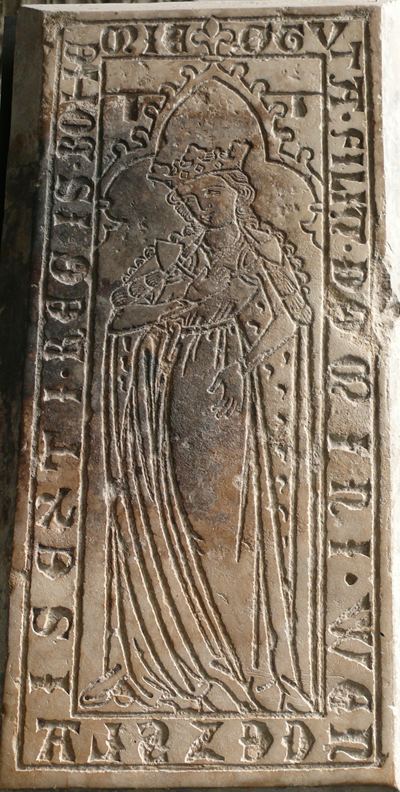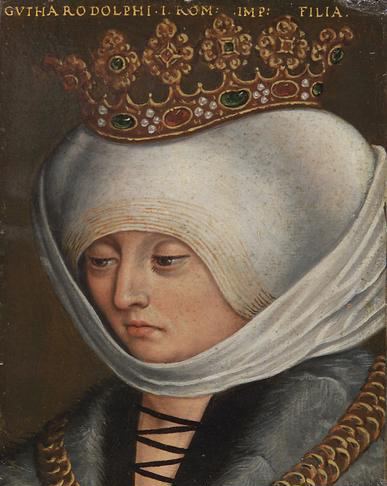Tenure 1285–1297 Name Judith Habsburg Mother Gertrude of Hohenburg | Tenure 1291–1297 | |
 | ||
Issue Wenceslaus III of BohemiaAnne, Queen of BohemiaElisabeth, Queen of BohemiaMargaret, Duchess of Brieg Children Wenceslaus III of Bohemia, Elizabeth of Bohemia Parents Gertrude of Hohenburg, Rudolf I of Germany Similar People Wenceslaus II of Bohemia, Rudolf I of Germany, Wenceslaus III of Bohemia, Elizabeth Richeza of Poland, Albert I of Germany | ||
Judith (13 March 1271 – 21 May 1297), also named Guta (Czech: Guta Habsburská), a member of the House of Habsburg, was the youngest daughter of King Rudolf I of Germany and his wife Gertrude of Hohenburg. She was Queen consort of Bohemia and Poland from 1285 until her death, by her marriage with the Přemyslid king Wenceslaus II.
Contents

Biography
Judith was born in the Swabian town of Rheinfelden, where her father still resided as a count (Graf) before he was elected King of the Romans in 1273. When she was five, she became the object of her father's political plans: on 21 October 1276 King Rudolf accepted the homage of his bitter rival King Ottokar II of Bohemia in the Austrian capital Vienna, and to seal the peace, both decided that Judith should marry Ottokar's son and heir Prince Wenceslaus II. The agreement, however, did not last and the conflict erupted again, ending with King Ottokar's final defeat and death in the 1278 Battle on the Marchfeld.
In order to secure his rule, King Rudolf entered a successful marriage policy. Judith's elder sisters also married powerful kings and dukes: in 1273 Matilda married the Wittelsbach duke Louis II of Bavaria, and her sister Clemence married Prince Charles Martel of Anjou, son of King Charles II of Naples, in 1281. Rudolf's daughter Agnes married the Ascanian duke Albert II of Saxony, her sister Hedwig maried Margrave Otto VI of Brandenburg.
After King Ottokar's death, the Brandenburg margrave Otto V had guardianship over minor Prince Wenceslaus II, acting as Bohemian regent. After conflicts arose with Ottokar's widow Kunigunda of Halych, Margrave Otto temporarily held Wenceslaus as a prisoner at Bezděz Castle and in the Ascanian fortress of Spandau in Brandenburg. He did not return to Prague until 1283.
As part of a reconciliation process, the formal engagement between Judith and Wenceslaus was renewed in 1279 at Jihlava; nevertheless, the bridal couple did not met until in January 1285 a wedding ceremony was held by the Přemyslid and Habsburg dynasties in the City of Cheb (Eger). The bride was given a dowry "from the Duchy of Austria, Moravian border to the border of Danube". The ceremony in Cheb was followed by a "festive" wedding night, but soon after, King Rudolf took Judith back to Germany, since she was still of a young age. Moreover, the morganatic second marriage of Wenceslaus' mother Kunigunda with the Bohemian noble Zavis of Falkenstein appeared inacceptable to the king.
Though Kunigunda died later in that year and Wenceslaus II had sworn an oath of fealty (Lehnseid) to Rudolf in order to receive his Bohemian heritage, his coronation as King of Bohemia had to be postponed as Judith was not present. In Summer 1287, she did eventually leave her family in Germany and came to the Prague court to be with her husband. One year later, Wenceslaus took over the political power. Like King Rudolf, Judith hated Wenceslaus' stepfather Zavis of Falkenstein, who had acted as regent with the dowager queen Kunigunda. Judith urged Wenceslaus bring Zavis to trial and he was eventually arrested and executed at Hluboká Castle in 1290, five years after the death of Kunigunda.
Upon her father's death in 1291, Judith further tried to reconcile her husband with Rudolf's son and heir Albert of Habsburg, her elder brother, who struggled for his succession with Count Adolf of Nassau. She also brought German influences to the Prague court, like the introduction of knights, and made Prague a cultural centre of the Holy Roman Empire.
Judith and her husband Wenceslaus II were finally crowned Queen and King of Bohemia on 2 June 1297. Judith was not in good health at the time, having just given birth to her tenth child. She died a few weeks after the ceremony in Prague, at age twenty-six. She had been pregnant during much of her twelve years of marriage, giving birth almost once per year. Worn out, she died shortly after giving birth to her youngest child and namesake, the stillborn Judith. In 1303 her husband went on to marry the Piast princess Elizabeth Richeza of Poland, who bore him another daughter, Agnes.
According to the family chronicles, Judith was described as beautiful, noble and virtuous. She supported her husband's claim on the Kingdom of Poland, where he ruled over the Seniorate Province at Kraków since 1291 and was able to succeed King Przemysł II in 1296. All of the Habsburg rulers over the Lands of the Bohemian Crown from 1526 onward were descended from Judith through her daughter Elizabeth.
Issue
Wenceslaus II and Judith had ten children:
- Přemysl Otakar (6 May 1288 – 19 November 1288).
- Wenceslaus III (6 October 1289 – 4 August 1306); King of Bohemia, King of Hungary and King of Poland.
- Agnes (6 October 1289 – after 1292 before 1306), twin of Wenceslaus III, betrothed to Rupert of Nassau, son of King Adolf of Germany, but died young.
- Anna (10 October 1290 – 3 September 1313), married in 1306 to Duke Henry of Carinthia.
- Elizabeth (20 January 1292 – 28 September 1330), married in 1310 to John I of Bohemia.
- Judith (3 March 1293 – 3 August 1294).
- John (26 February 1294 – 1 March 1295).
- John (21 February 1295 – 6 December 1296).
- Margareta (21 February 1296 – 8 April 1322), married to Bolesław III the Generous, Duke of Wrocław.
- Judith (born and died 21 May 1297).
Of the ten children only four lived to adulthood.
Family legacy
Wenceslaus III and then Anna and Elisabeth succeeded their father as rulers of Bohemia. Elisabeth was the mother of Charles IV, Holy Roman Emperor, his son was Sigismund, Holy Roman Emperor.
Judith is also an ancestor of Anne of Denmark, who married James I of England. Among Anne's children were Charles I of England and Elizabeth of Bohemia; Elizabeth is one of Judith's successors as Queen of Bohemia.
